
| Abercwmboi | |
| A glance at the 1847 tithe map for Abercwmboi reveals how rural the district was at this time, with only three properties being shown within the area we now know as Abercwmboi. These being, Penrhiw Anghan, Abercwmboy Ucha and Blaencwmboy. By 1868 however, the first edition Ordnance Survey map reveals a very different picture, with a number of recognisable streets appearing, including John Street, Jenkin Street, Richards Street, Margaret Street and William Street. | |
 |
|
 |
The reason for this rapid development can be seen further to the South, it being the presence of Abercwmboi Colliery. For just as with other villages in the Cynon valley it was the sinking of a colliery within the district, which sparked the growth of the modern village we know today. With houses being built to accommodate the sudden influx of people that such collieries brought and public amenities being established to serve the needs of these people. Left: One of the early shops of Abercwmboi which were in the main "General Stores" trading in almost anything you would need in your daily life. |
The names of some of the earliest establishments such as the Cap Coch Inn built in 1865 and the Cap Coch School built in 1868 reflect the former name of the village. Local legend has it that Cap Coch derived its name from a local publican who wore a red cap on cockfighting occasions. Right: The Cap Coch Inn |
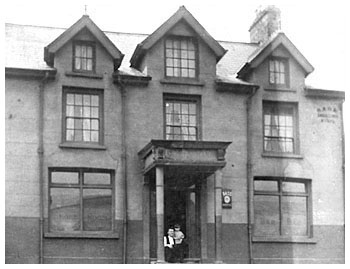 |
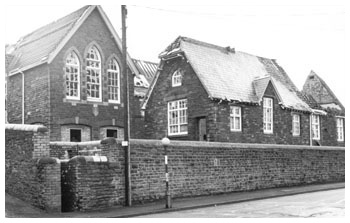 |
Places of worship were also established. One of the earliest being Bethesda Welsh Baptist Chapel built in 1864. The established church did not have a place of worship until an iron built St Peter's Church, was constructed around 1918. Abercwmboi Workmen's Hall and Institute, which was a two-storied building, built in 1913, was the focal point of village life at that time. Left: The badly vandalised remains of Cap Coch School |
| Abercwmboi Coal Industry | |
It was David Davies who brought the coal industry to Abercwmboi. He began his business career by opening a grocers shop in Hirwaun, but moved into the coal industry once his family had grown up enough to run the shop. After a successful venture in Blaengwawr he moved his attention to Abercwmboi, sinking a new pit there in 1851. This colliery (also known as Cap Coch Colliery) proved to be highly successful producing over 90,000 tons of coal in 1869. In 1881 the colliery was sold to the Powell Duffryn Steam Coal Company, who continued to work it until 1923 when it was merged with Aberaman Colliery. Abercwmboi colliery continued to operate as a pumping pit until 1970 when it was closed by the N.C.B. who took over ownership when the coal industry was nationalised in 1947. The Powell Duffryn Steam Coal Company also operated a level in the Abercwmboi district, known as the Clay Level. Opened in 1882 this mined fireclay (which is almost always found between the seams of coal) for the pipeworks in Aberaman (Which occupied a site near the present-day Kwik Save store) and also coal for coking purposes |
|
| The Phurnacite Plant | |
| The history of the Phurnacite Plant at Abercwmboi goes back to 1939, when operations were started by Powell Duffryn Limited to produce briquettes from the waste steam coal that was too small to sell. This was crushed, dried and mixed with pitch and a heating process used to removed most of the smoke content. It wasn't until 1942 that the plant became fully operational and by 1951-1952 the plant had been extended and at its peak was producing some 1 million tons of briquettes per year. | |
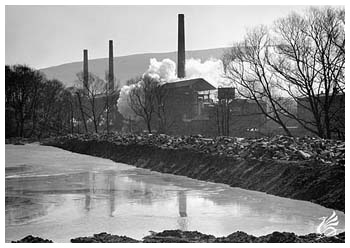 |
By the mid 1970's fortunes were beginning to change with the lessening use of fossil based fuels and with continuing pollution complaints from nearby residents the future for the plant looked bleak. Late 1979 saw the proposed modernisation of the plant and plans were submitted for a MHT (Mild Heat Treatment) process, which it was claimed, would reduce pollution caused by the Disticoke plant by 90%. Both the owners and locals met on many occasions to discuss the future of the plans but failed to find any common ground. Quotes in the press such as "Britain's Dirtiest Factory" did nothing to alleviate peoples concern. Left: The Phurnacite Plant |
By the late 1980's the owners were refused permission for the new plant, blaming lack of investment in the £100 million project by the Government and the decision was taken to finally close operations. Many people complained at the closure of the works that employed over 1000 local people and with the unemployment in the Cynon Valley at the time running at over 10% of the population, it was not a universally popular decision. The general consensus of opinion of most Cynon Valley residents was a feeling of relief that such a major source of pollution and health problems would be gone forever. A competition "Blow-Up-A-Chimney" was held by the Cynon Leader and the winner, Tanya Jenkins from Miskin pressed the button, which fired the explosive charges at the base of the four chimneystacks to bring them to the ground. Within a matter of seconds an era was over, closing a long chapter in the valleys history. |
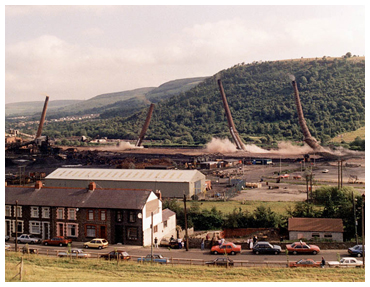 |
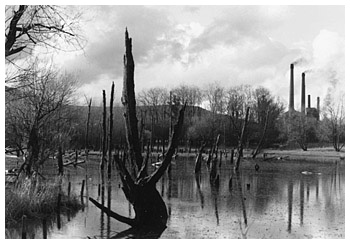 |
The legacy of Phurnacite operations remains to this day with evidence of the pollution caused to the ground and water of the area, which is still an eyesore that blights the area between Abercwmboi and Mountain Ash. A report by Byron Lewis and Max Wallis of Friends of the Earth Cymru called "Phurnacite Toxic Legacy" published in September 1997 explains many of the problems of "walking away" from such pollution. Left: Trees poisoned by pollution with the Phurnacite Plant in the background |